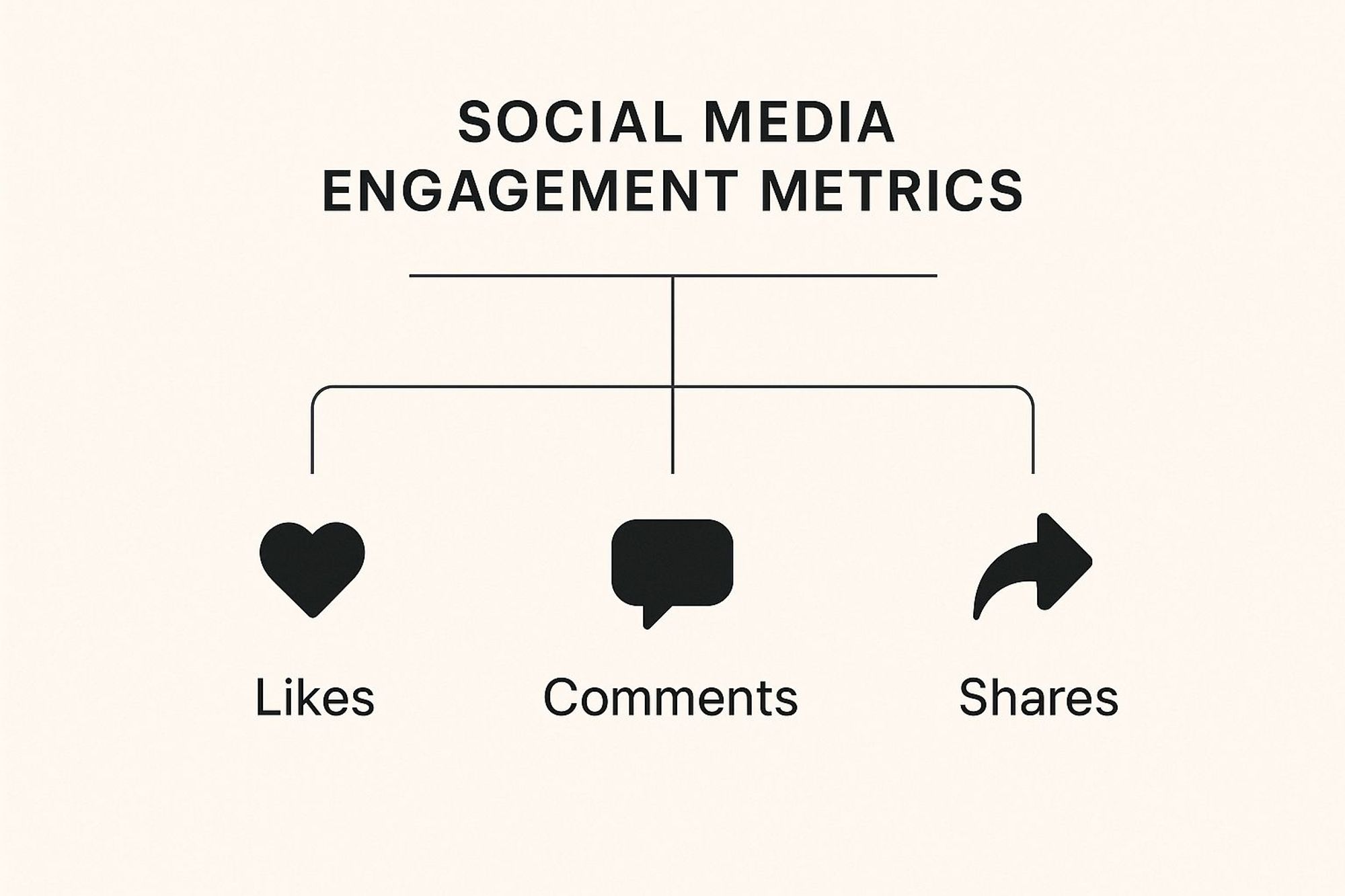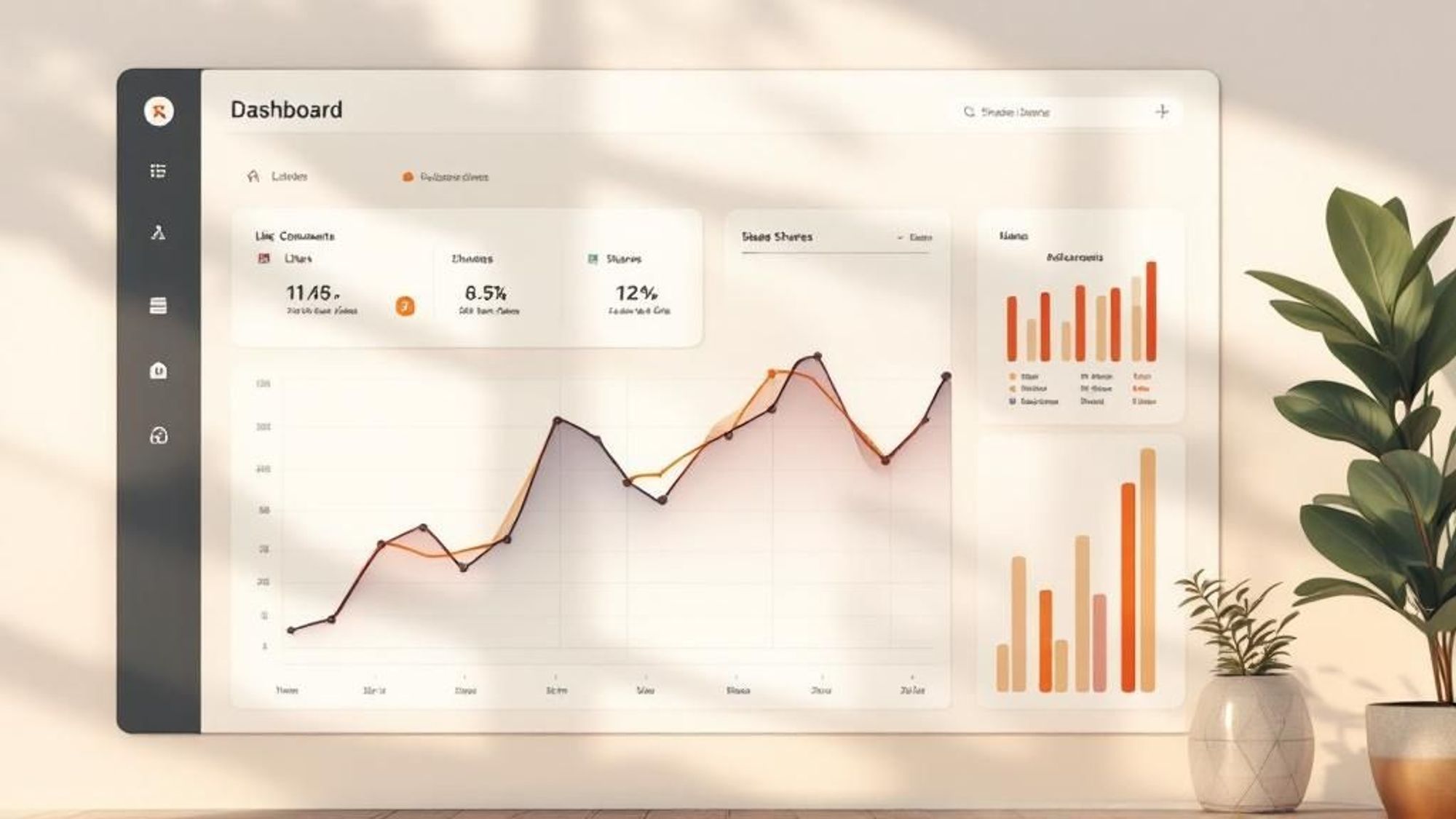Tuesday, July 8, 2025
Master Social Media Engagement Metrics for Better Growth


Let’s be honest—a huge follower count means very little if no one is actually paying attention. Real success on social media isn't about shouting into a void; it's about building a living, breathing community that talks back. This is where social media engagement metrics come in, acting as your guide.
These metrics are the data points that show you how people are actually interacting with your content. We're talking about the good stuff: likes, comments, shares, and clicks. A massive follower list is just a vanity number if it's not paired with these genuine interactions. They're the vital signs of your online community's health.
Why Engagement Metrics Define Social Media Success

Think of it like this: a high follower count is like having a giant stadium full of people, but they're all looking at their phones. High engagement, on the other hand, is like hosting an intimate concert where every single person is singing along. They don't just see your content; they feel something and are compelled to react.
The Big Shift Toward Real Interaction
Social media feeds are getting crowded, especially with a flood of AI-generated content making it tougher than ever to capture real human attention. Because of this, the platforms themselves are changing. They're starting to favor authentic conversations and meaningful interactions over just blasting content to the masses.
This evolution means your content has to be better and more relevant to stand out. It also makes your engagement data more precious than ever. It's the hard proof that you're cutting through the noise and connecting with people on a genuine level.
Engagement metrics are the pulse of your social media health. They signal a healthy, two-way conversation with your audience, transforming passive followers into an active community that trusts and champions your brand.
From Engagement to Actual Business Goals
At the end of the day, strong engagement is what leads to real-world results. A community that’s actively liking, commenting on, and sharing your stuff is also far more likely to click your links, check out your website, and ultimately become paying customers.
For creators and brands, this is a direct line to the bottom line. It's the foundation for monetizing a social media presence. This principle is so powerful that even emerging fields rely on it, with specific strategies for monetizing AI influencers being built entirely around demonstrating strong, verifiable engagement.
Consider this guide your playbook. We're moving past dictionary definitions to give you a clear, actionable plan for measuring—and boosting—the metrics that truly move the needle.
Understanding the Four Pillars of Engagement
To really get a handle on social media engagement metrics, you have to stop thinking of "engagement" as one big, fuzzy concept. It’s not just a single number. Instead, think of it like a building held up by four strong pillars. Each pillar is a different kind of user action, and each one tells you something unique about how people are actually connecting with your brand.
Some actions are just a quick nod of approval, almost like polite applause. Others are powerful endorsements that can turn a casual follower into a genuine advocate for your brand. When you start sorting your metrics this way, you can finally move beyond just counting interactions and start understanding the story your data is telling.
Let's break down these four pillars.
The Applause Pillar
This is the most common and basic type of engagement you'll see. Think of it exactly like the audience's applause after a good performance—it's a quick, low-effort signal that your content was seen and liked. It’s the simplest form of positive feedback.
Here are the key metrics that fall under the Applause Pillar:
- Likes and Reactions: A simple thumbs-up, heart, or other reaction on platforms like Facebook and Instagram. This is the most fundamental signal of approval.
- Favorites: The equivalent of a "like" on platforms like X (formerly Twitter).
- Saves: On Instagram and Pinterest, a "save" is a much stronger form of applause. It means a user found your content so useful that they plan to come back to it later, treating it more like a resource than just another post.
While these metrics are super easy to collect, they represent the shallowest level of engagement. They're a good sign that your content is hitting the mark on a surface level, but they don't always mean someone has a deep connection to your brand or is ready to take a bigger step.
The Amplification Pillar
Amplification is what happens when your audience loves your content so much that they decide to share it with their own followers. This is where your community becomes an extension of your marketing team, spreading your message for you, completely organically. It’s one of the most valuable forms of reach you can get.
When a user shares your content, they are putting their own reputation on the line to endorse your brand. This action is a powerful vote of confidence and a clear sign that your content provides immense value.
These are the core metrics of amplification:
- Shares: The classic "share" button on Facebook or LinkedIn.
- Retweets and Quote Tweets: On X, a simple retweet broadcasts your post as-is. A quote tweet is even better—it adds the user's own commentary, kicking off a whole new conversation around your content.
- Repins: This is the main sharing action on Pinterest, a platform built entirely around curating and amplifying content.
High amplification rates are a fantastic sign that you’re creating stuff people find genuinely useful, entertaining, or important enough to vouch for.
This simple diagram shows the foundational metrics—Likes, Comments, and Shares—that form the basis of all engagement.

Each of these core actions represents a different level of investment from your audience, ranging from simple approval to active participation and full-blown endorsement.
The Conversation Pillar
This pillar is all about the back-and-forth—the actual dialogue happening between you and your audience. It’s where a real community starts to take shape. Conversation metrics prove that your content sparked enough interest, curiosity, or emotion to make someone stop scrolling and actually type out a response.
The key metrics for conversation are:
- Comments and Replies: This is your most direct line of feedback. Comments offer priceless insights into what your audience is thinking, asking, and feeling.
- Direct Messages (DMs): A private conversation often signals a much higher level of interest or a specific customer service need. It's a more personal connection.
- Brand Mentions: This is when people talk about your brand without directly replying to one of your posts. It shows you’re part of the wider conversation in your niche.
When the conversation pillar is strong, you know you have a healthy, active community, not just a passive audience.
The Conversion Pillar
Finally, we get to the pillar that connects your social media work directly to business results. These are the metrics that track when a user takes a specific action you want them to take—an action that moves them closer to becoming a customer. This is the ultimate proof that your engagement is generating tangible value.
Essential conversion metrics include:
- Clicks: The number of times people click on a link in your post, bio, or ad. It's the first step off the social platform and onto your turf.
- Website Visits: Traffic driven straight from your social media channels to your website.
- Store Visits or Purchases: For businesses using social commerce features, this tracks direct sales made through the platform.
Once you understand these four pillars, you have a complete framework for analyzing your social media engagement metrics. Instead of just looking at a pile of raw numbers, you can now see the different ways your audience connects with you and what each of those actions truly means for your brand.
The Four Pillars of Engagement Metrics
To bring it all together, think of engagement as a spectrum of actions. Each type of interaction tells a different part of the story about your audience's relationship with your brand. The table below breaks down the four primary categories, the specific metrics to watch, and what they really measure.
| Pillar of Engagement | Key Metrics | What It Measures |
|---|---|---|
| Applause | Likes, Reactions, Favorites | Awareness & Appeal: Quick, low-effort signals that your content is being seen and appreciated on a surface level. |
| Amplification | Shares, Retweets, Repins | Advocacy & Reach: How valuable and share-worthy your content is; your audience's willingness to endorse your brand. |
| Conversation | Comments, Replies, DMs, Mentions | Community & Connection: The level of dialogue and direct interaction your content inspires, building a loyal community. |
| Conversion | Link Clicks, Website Visits, Sales | Action & Business Impact: The effectiveness of your social media efforts in driving tangible business outcomes. |
By separating your metrics into these four pillars, you move from simply counting interactions to understanding the intent behind them. This strategic view is what allows you to build a social media presence that doesn't just get attention, but actually drives meaningful results.
How to Calculate the Engagement Rates That Matter

Counting up likes and shares is one thing, but the real magic happens when you turn those raw numbers into standardized rates. Engagement rates are what give you a clear, comparable percentage that shows how well your content actually connects with people, no matter how big your audience is or what the algorithm is doing that day.
Think about it. Knowing you got 50 likes is nice, but knowing that same post earned a 5% engagement rate is truly powerful. It adds crucial context, letting you fairly compare a post that reached 1,000 people to one that reached 10,000. By plugging your numbers into a few simple formulas, you can start to uncover the real story behind your social media engagement metrics.
Let’s roll up our sleeves and get into the simple math behind the three engagement rate formulas you should be using.
Engagement Rate per Reach (ERR)
This is probably the most honest way to look at your engagement. Your Engagement Rate per Reach (ERR) calculates the percentage of people who chose to interact after seeing your content. Since not every one of your followers sees every single post, using reach as your baseline is way more accurate than just using your follower count.
The formula couldn't be simpler:
(Total Engagements on a Post / Reach of that Post) x 100 = ERR (%)
Let's see it in action:
- You share an Instagram post that earns 300 engagements (a mix of likes, comments, and saves).
- Your Instagram Insights show the post reached 4,500 unique accounts.
- The math is: (300 / 4,500) x 100 = 6.67% ERR.
This tells you that nearly 7% of the people who were actually served your content found it compelling enough to interact. ERR is the perfect metric for figuring out how interesting your content is to the people the algorithm is putting it in front of.
Engagement Rate per Post (ERP)
While ERR looks at engagement versus actual viewers, Engagement Rate per Post (ERP) measures it against your total number of followers. This formula is less about a single post's viral potential and more about how your content performs relative to your established community. It's fantastic for quick, consistent tracking over time.
This metric is particularly useful for getting a pulse on the engagement level of your most loyal followers. If you're looking to grow that base, check out our guide on how to get more social media followers.
Here’s how you calculate it:
(Total Engagements on a Post / Total Followers) x 100 = ERP (%)
Here's a quick example:
- You publish a LinkedIn post that gets 150 engagements.
- Your company page has 10,000 followers.
- The calculation is: (150 / 10,000) x 100 = 1.5% ERP.
Use ERP when you want a stable benchmark (your follower count) to compare the performance of different posts against each other. It’s also the go-to metric for competitor analysis, since follower counts are public information while reach is kept private.
Daily Engagement Rate (DER)
If you need to zoom out and check the overall health of your account on a day-to-day basis, the Daily Engagement Rate (DER) is your best friend. Instead of focusing on a single post, this formula looks at how many of your followers engage with your account on any given day, no matter when the content they're interacting with was originally posted.
This is the formula:
(Total Engagements in a Day / Total Followers) x 100 = DER (%)
Let's break it down:
- Across all your posts, you racked up a total of 400 engagements on Tuesday.
- You have 10,000 followers.
- The math is: (400 / 10,000) x 100 = 4% DER.
DER is brilliant for spotting trends in your community’s behavior. Did your engagement jump on a day you posted a video? Did it drop when you only shared text? This metric helps you understand the daily rhythm of your audience. Mastering these formulas empowers you to look past the surface-level numbers and find the real story hiding in your social media performance.
Tailoring Your Strategy for Each Social Platform
Trying to use the same social media strategy for every platform is like speaking the same language in every country you visit—you might get by, but you’ll never truly connect. It just doesn't work. Each network has its own vibe, its own algorithm, and its own audience expectations.
This means a ‘like’ on Instagram doesn’t mean the same thing as a ‘share’ on LinkedIn. To really get a grip on your social media engagement metrics, you have to learn the unique "language" of each channel. A one-size-fits-all approach misses the whole point. What gets people excited on TikTok will likely get crickets on a professional hub like LinkedIn. Once you get these nuances, you can stop shouting into the void with generic content and start having real conversations that resonate.
Instagram and Facebook: The Visual Powerhouses
For visual-first platforms like Instagram and Facebook, engagement is so much more than just a like. Sure, likes are a nice little pat on the back, but the metrics that really matter tell you a much deeper story about how valuable your content is.
- Saves (Instagram): This is a gold-star metric. When someone saves your post, they’re telling the algorithm, "This is so good, I need to come back to it." It’s a huge signal that you’re providing real, lasting value.
- Story Replies & Poll Votes: Think of these as a direct line to your audience. A reply kicks off a one-on-one chat, while votes on polls and quizzes show people are actively playing along and giving you instant feedback.
- Shares to Stories: This is a public endorsement. Someone liked your post so much they put it on their own Story for their friends to see, which can be a massive boost for your reach.
On Facebook, you're looking for substance. A detailed comment that sparks a real back-and-forth is far more powerful than a simple reaction. And when someone shares your post, they’re broadcasting it to their entire network—a clear sign it was worth their time.
LinkedIn: The Professional Network
On LinkedIn, it's a completely different game. Engagement here is all about building authority, sharing expertise, and adding professional value. People are scrolling for industry insights and career advice, not cat memes.
Because of that, the metrics that count are the ones that reflect real professional dialogue:
- Thoughtful Comments: One long, insightful comment on a LinkedIn post can be worth more than a hundred likes. It proves your content was provocative enough to start a genuine professional discussion.
- Shares with Commentary: When someone shares your post and adds their own two cents, it’s like getting a public co-sign from a peer. It gives your message third-party validation and amplifies it to their network.
- Document Clicks: If you're sharing resources like PDFs or presentations, the number of clicks and downloads is a rock-solid indicator that you're providing tangible, useful information.
X (Formerly Twitter) and TikTok: The Conversation Drivers
X and TikTok are all about speed, trends, and real-time conversation. Engagement here is fast, interactive, and often built around jumping into the fray.
On X, the whole point is to spark a conversation. Replies and Quote Tweets are way more valuable than likes because they create new branches of discussion and pull more people in. A high reply count is a sign you said something that made people think.
And on TikTok, just watching isn't enough. The algorithm loves content that makes people do something.
- Completion Rate: This is critical. How much of your video people actually watch tells the algorithm if your content is truly captivating or just scroll-past material.
- Shares: The share button (especially sending a video via text or another app) is one of the biggest signals that you've created something amazing.
- Stitches and Duets: This is the ultimate form of engagement. Someone liked your video so much that they used it to create their own content—it doesn't get much better than that.
Of course, tailoring your strategy also means using platform-specific tactics to drive results. For example, mastering TikTok link in bio strategies can turn engaged viewers into website traffic. And honestly, trying to track all these different metrics across every platform can get overwhelming fast. That’s where a centralized tool comes in. For a closer look, see how a social media analytics dashboard can pull all this data into one place, giving you a clear, simple view of what’s actually working.
How to Set Realistic Benchmarks and Track Progress

Knowing how to calculate your social media engagement metrics is one thing, but here’s the real question: are your numbers actually any good? It’s so easy to get fixated on industry averages, but genuine growth comes from beating your most important competitor—your own past performance.
Think of it like training for a marathon. You wouldn't show up on day one and try to match an elite runner's pace. That’s a recipe for burnout. Instead, you’d track your own mile time and work on shaving off a few seconds each week. Social media is the same. Your most valuable benchmark is what you did yesterday, last week, and last month.
Finding Your Performance Baseline
Before you can get better, you have to know where you’re starting. This means doing a quick content audit to figure out your baseline engagement rate. It sounds more intimidating than it is, and it's the foundation for every goal you'll set from here on out.
Here’s a simple way to do it:
- Gather Your Data: Pull up your posts from the last 30-90 days.
- Calculate Per-Post Engagement: Use the Engagement Rate per Reach (ERR) formula for each individual post. This tells you what percentage of the people who saw it actually interacted.
- Find Your Average: Add up all those individual engagement rates and divide by the number of posts you analyzed. That average is your baseline engagement rate. It’s your starting line.
This single number is now your north star. It's the benchmark you’ll measure all your future work against, giving you a clear, personalized target to aim for.
Setting S.M.A.R.T. Goals for Engagement
Once you have your baseline, you can finally move past vague wishes like "get more engagement" and start setting goals that actually move the needle. The best framework for this is S.M.A.R.T. goals. It’s a classic for a reason—it forces you to be clear, trackable, and realistic.
A S.M.A.R.T. goal for social media isn't just a target; it's a complete plan. It forces you to think through the "what, how, when, and why" of your engagement strategy, turning abstract ambitions into an actionable roadmap.
Let’s break down what that looks like in practice:
- Specific: Don't just say "increase engagement." Get granular. Try, "Increase the average number of comments on our Instagram posts."
- Measurable: Your baseline makes this easy. "Increase our average ERR from 2.5% to 3.5%."
- Achievable: Aim for steady, realistic growth. A 1% jump is a fantastic goal. Shooting for a 50% increase overnight is probably setting yourself up for disappointment.
- Relevant: Make sure the goal connects to a bigger business objective. "Increasing comments helps us build a stronger community and gather direct feedback on our new product line."
- Time-bound: Set a deadline. "Achieve this 1% increase over the next quarter (Q3)."
Tracking Progress with the Right Tools
Trying to track all of this manually in a spreadsheet is not only a headache but also incredibly prone to error. This is where analytics and listening tools become your best friends. A solid dashboard, like the one in Schedul, helps you see your progress in real-time, making it easy to spot what’s working and what isn't without drowning in data.
Social listening tools are also a huge asset. In fact, teams that use them report being up to twice as confident in their social media ROI compared to teams that don't. You can discover more about these findings on Talkwalker.com. And of course, when you post plays a big part, too. To really dial things in, it's worth exploring the best time to post on social media for your audience.
When you combine smart goals with powerful tools, you stop guessing and start building a predictable engine for growth.
Alright, you've got your social media engagement metrics. Now what? Knowing your numbers is one thing, but if you don't have a plan to make them better, they're just... numbers. It’s time to turn those insights into action.
Let's get into the nitty-gritty of proven strategies that directly pump up the metrics we've been talking about, from comments and shares to those all-important clicks. Think of it like a toolbox. You wouldn't use a hammer for a screw, right? Same goes for social media. A generic approach won't cut it. You need the right tool for the right job to build a community that's not just following you, but is actively invested.
Spark Conversations with Questions and Polls
The most straightforward way to get more comments and replies? Just ask. Seriously. Posing a good open-ended question is like opening the door to a conversation. It turns your post from a monologue into a dialogue and shows your audience you actually care what they think.
So instead of just posting a photo of your new product, try asking, "What's the one feature you're most excited to try?" That tiny shift makes all the difference. It invites people to participate instead of just passively scrolling by.
Polls and quizzes on platforms like Instagram Stories or X are another goldmine. They're super low-effort for your followers but give you instant feedback. Every little interaction like this strengthens the bond with your brand and sends positive signals to the platform's algorithm.
Create High-Value, Sharable Content
If you want to see your amplification metrics (shares, retweets) climb, you need to give people something worth sharing. We're talking about content that's so genuinely useful, funny, or beautiful that sharing it makes your audience look good to their followers.
- Infographics and Checklists: These are perfect for breaking down complex topics into something simple and visually appealing. People love to share them because they offer instant value that others can save and use later.
- Short-Form Video: Let's be real, video isn't just an option anymore—it's essential. A staggering 78% of people prefer to learn about new products by watching short videos. And marketers are listening, with 93% planning to beef up their social media marketing efforts.
Creating killer, share-worthy content is the foundation of any solid engagement strategy. For a deeper dive, check out our complete guide on how to boost social media engagement.
Run Contests and Build Community
Nothing sparks a fire under engagement like a great contest or giveaway. It creates a sudden burst of excitement and gives people a crystal-clear reason to interact. Asking followers to do things like "tag a friend" or "share this post" is a direct way to juice the exact metrics you're trying to improve, often expanding your reach like wildfire.
Building a community isn't just about what you post; it's about how you interact. Responding promptly and thoughtfully to comments shows that a real person is listening, which fosters loyalty and encourages others to join the conversation.
Of course, staying on top of all this interaction can feel like a full-time job. To keep things running smoothly, you might want to look into some advanced social media automation tools. They can take care of scheduling and number-crunching, freeing you up to focus on what really matters: making those human-to-human connections that build a thriving community.
Frequently Asked Questions About Engagement Metrics
It’s completely normal to have questions when you're diving into the world of social media metrics. It can feel like you're learning a whole new language, with every platform having its own quirks. Let's clear up some of the most common questions so you can start using this data with confidence.
What Is a Good Engagement Rate?
There’s no magic number here. What counts as a “good” engagement rate really depends on your industry, the platform you’re on, and even the size of your audience.
While some studies point to a general average of 1% to 5% across most platforms, the only benchmark that truly matters is your own. The real goal is to consistently improve on your past performance, not to chase a generic industry figure. For instance, a small account with a super-dedicated niche following might easily pull in engagement rates over 10%. On the other hand, a huge global brand with millions of followers could see 1.5% as a massive win. Focus on progress, not perfection.
How Do I Handle Negative Engagement?
Believe it or not, negative comments and "angry" reactions are a form of engagement—and they’re packed with valuable information. It's tempting to delete or ignore them (unless they're spam or abusive, of course), but you should see them as an opportunity.
Responding to a complaint quickly and professionally can flip a bad experience into a good one. It also sends a powerful message to everyone else watching: you're listening.
Don't fear negative feedback; it's a direct line to customer pain points. Addressing criticism openly can build trust and provide insights you wouldn't get anywhere else, strengthening your overall brand perception and community trust.
Which Metric Is the Most Important?
The "most important" metric is whichever one aligns with your current goal. There's no single winner.
- Want more people to know about your brand? Focus on Reach and Shares.
- Trying to build a community? Prioritize Comments and Replies.
- Need to drive sales? Keep a close eye on Link Clicks and Conversion Rate.
The best strategy is to define your objective for each post or campaign and then zero in on the metric that best measures that success. For example, building a vibrant social media community demands a different focus than just driving website traffic.
This flexible approach is crucial, especially when you consider that the average person uses about 6.83 different social networks every month. As you can learn more from Sprout Social's research, your strategy has to adapt to what works best on each platform to truly capture your audience's attention.
Frequently Asked Questions
Here’s a quick-glance table to answer some of the most common questions we get about social media engagement.
| Question | Answer |
|---|---|
| What is a good engagement rate? | It varies, but a general benchmark is 1-5%. Focus on improving your own historical average rather than chasing a generic number. A small, niche account might see 10%, while a large brand might find 1.5% to be excellent. |
| Should I delete negative comments? | No, unless they are abusive or spam. Negative feedback is an opportunity to show you're listening and to address customer concerns publicly, which can build trust. |
| Which engagement metric is the best? | It depends entirely on your goal. For brand awareness, focus on Reach. For community building, prioritize Comments. For sales, track Link Clicks. There is no single "best" metric for every situation. |
| How often should I track my metrics? | It depends on your campaign's pace. For active campaigns, check daily or every few days. For general content, a weekly or bi-weekly check-in is usually enough to spot trends without getting lost in minor fluctuations. |
| Do all platforms calculate rates the same? | Not always. For example, some platforms include saves in their engagement calculations, while others don't. Always check the specific formula for the platform you're analyzing to ensure you're comparing apples to apples. |
Hopefully, these answers give you a clearer picture of how to approach your social media metrics. The key is to move from simply collecting data to using it to make smarter decisions.
Ready to take control of your social media engagement metrics? Schedul provides a powerful, all-in-one dashboard to schedule content, analyze performance, and track the numbers that matter most to your growth. Start your free trial today and turn your data into results.
No credit card required!